Rizal’s Life and Works PDF

| Title | Rizal’s Life and Works |
|---|---|
| Author | Distant Snow |
| Course | Bachelor of Science In Accounting Information System |
| Institution | Laguna University |
| Pages | 82 |
| File Size | 2.1 MB |
| File Type | |
| Total Downloads | 13 |
| Total Views | 160 |
Summary
Download Rizal’s Life and Works PDF
Description
Rizal’s Life and Works Enrique G. Santos Jeiel F. Ibañez Mayra Christina M. Ambrocio, DEM Mario F. Diozon Francisco C. Doble Arthur P. Limongco
LAGUNA UNIVERSITY Vision Laguna University shall be a socially responsive educational institution of choice providing holistically developed individuals in the Asia-Pacific Region.
Mission Laguna University is committed to produce academically prepared and technically skilled individuals who are socially and morally upright.
Table of Contents
Module 1: The Hero, His Childhood and Family Introduction Learning Outcomes Lesson 1. The Rizal’s Law Lesson 2. A Hero is Born
1 1 1 2 5
Module 2: Rizal’s Educational Background Introduction Learning Outcomes Lesson 1. Childhood Years in Calamba Lesson 2. Early Education in Calamba and Binan Lesson 3: Scholastic Triumphs at Ateneo De Manila Lesson 4. Medical Studies at the University of Santo Tomas
23 23 23 24 26 31 38
Module 3: Academics in Europe Introduction Learning Outcomes Lesson 1. In Sunny Spain Lesson 2. Rizal in Paris and Berlin
46 46 46 47 52
Module 4: Rizal’s Novel and Blumentritt Introduction Learning Outcomes Lesson 1. The Savior of Noli Me Tangere Lesson 2. Noli Me Tangere Lesson 3. The First Meeting of Rizal and Blumentritt
59 59 59 60 63 66
List of Figures Figure
Description
1.1 1.2
Rizal’s Family
1.3 2.1 2.2 2.3 2.4 2.5 3.1 3.2 4.1 4.2 4.3
Rizal’s Ancestral Home Calamba Symbol Story of the Moth Told by Rizal’s Mother Rizal as a Young Boy Ateneo Municipal (Intramuros) UST (Intramuros) Spain in World Map Central University of Madrid Maximo Viola Noli Me Tangere (Original Copy) Rizal and Blumentritt
Jose Rizal
11 14 15 24 25 26 31 38 47 50
Course Code:
GEM
Course Name:
Rizal’s Life and Works
Course Description:
A study of the life, works and writings of Dr. Jose P. Rizal, the national hero and martyr, as they relate to the socio-political situation of the Philippines during his time and its implication to our present time. It traces the hero’s life, ideals, concept of education, good government, and nationalism as embodied in his writings.
Course Intended Learning Outcomes (CILO): At the end of the course, students should be able to: 1. Inculcate in the minds of students the inspiring life and achievement, especially the selfless contribution to the growth of nationalism, of our national hero, Dr. Jose P. Rizal, which have shaped to a large extent of our national identity. 2. Inspire the students with a special love of country through a closer study of the biography of Jose Rizal. 3. Inspire the students to dedicate their lives to the ideals of freedom and nationalism; 4. Develop in the minds of the students the moral virtues that could be learned through a closer look into the life of Dr. Jose Rizal; 5. Develop in a more realistic manner the ideals of moral character, personal discipline, and civic virtues as inspired by Dr. Rizal; 6. Develop a more meaningful understanding of the relevance of the study of the multi-faceted aspects of Rizal’s life so that the students may truly appreciate his great love and services of his country and fellowmen.
Course Requirements: ▪ ▪
Assessment Tasks - 60% Major Exams40% ____ Periodic Grade
100%
Prelim Grade = 60% (Activity 1-4) + 40% (Prelim exam)
Midterm Grade = 30 %( Prelim Grade) + 70 % [60% (Activity 57) + 40% (Midterm exam)] Final Grade = Total CS + Final Exam x 70% + 30% of the Midterm Final Grade = 30 %( Midterm Grade) + 70 % [60% (Activity 8-10) + 40% (Final exam)]
MODULE 1 THE HERO, HIS CHILDHOOD AND FAMILY
Int Introduction roduction
Being a part of General Education Course, readings in Rizal’s life, works and writings focus on the historiographical skills of the student. The student will be given a chance to read and reflect on the context and topics which have a great relation in our history. Students of Rizal will be required to read and analyze all information about Rizal. Students and teachers will have an interactive experience using the blended learning approach. Students were not allowed to parrot facts about Rizal’s past but to gain knowledge about Rizal’s experience against the Spanish colonizer which can be used in proposing solutions to the problems of Philippine society. Welcome to the first lesson of the course Life and Works of Jose Rizal. This lesson provides a discussion on the historical context and contents of the Rizal Law and examines the social, political and economic conditions in the Philippines in the 19th century. This covers the historical context of the Rizal Law to help you better understand the contents, rationale and importance of the law. In addition, it highlights the events during the 19th century which is helpful in making the life and works of Rizal be presented in a lighter and meaningful means.
Learning Outcomes At the end of this module, students should be able to: 1.
Discuss how Rizal Bill became a law;
2.
Explain the importance of Senate Bill and Republic Act 1425; and
3.
Describe the genealogy of Dr. Jose Rizal.
Lesson1. The Rizal’s Law (Republic Act 1425, 1956) Many Filipino students are curious why they are still required to study the life and works of Jose Rizal in college despite having studied the biography of Jose Rizal and his two novels in their high school years. They believe that it might just be a repetition of the things they have learned and that it would be a waste of time. Little did they know that they are mandated by the law to study the life and works of Jose Rizal not only in high school but also in college and they might not even have an idea what this law had gone through in order to be passed and approved. On June 12, 1956, Philippine Independence Day, the Republic Act 1425 (R.A. 1425) also known as the Rizal Law was passed. It is an act “to include in the Curricula of All Public and Private Schools, Colleges and Universities courses on the life, works and writings of Jose Rizal, particularly his novels Noli Me Tangere and El Filibusterismo. Authorizing the printing and distribution thereof, and for other purposes”. The sponsor of the said law (R.A. 1425) is our former president Jose P. Laurel. Senate bill 448 hopes to give people knowledge about the oppression suffered by the Filipinos during the Spanish era and for the Filipinos to understand themselves and their country better and realize the greatness of Rizal. Claro M. Recto is the main proponent of the senate bill 448. We all know in politics there were people called “opposition”, Francisco “Soc” Rodrigo argued that the bill is a violation of religious freedom because the religion that is only present in that bill is Roman Catholic, he ask “how about the protestant and other religious group”? Going back to the Rizal’s Law, there were three main goals of it:
1. To rededicate the lives of youth to the ideals of freedom and nationalism, for which our heroes lived and died. 2. To pay tribute to our national hero for devoting his life and works in shaping the Filipino’s character. 3. To gain an inspiring source of patriotism through the study of Ri zal’s life, works, and writings.
2
REPUBLIC ACT NO NO.. 1 1425 425 AN ACT TO INCLUDE IN THE CURRICULA OF ALL PUBLIC AN AND D PRIVAT PRIVATE E SCHOOLS, COLLEGES AND UNIVERSITIES C OURSES ON THE LIFE, WO WORKS RKS AND WRITING WRITINGS S OF JOSE RIZAL, PARTICULARLY HIS NOVELS NOLI ME TAN TANGERE GERE AND EL FILIBUSTERISMO, AUTHORIZING THE PRINTING AND DISTRIBU DISTRIBUTION TION THEREOF, AND FOR OTHER PURPOSES WHEREAS WHEREAS, today, more than any other period of our history, there is a need for a re-dedication to the ideals of freedom and nationalism for which our heroes lived and died; WHEREAS WHEREAS, it is meet that in honoring them, particularly the national hero and patriot, Jose Rizal, we remember with special fondness and devotion their lives and works that have shaped the national character; WHEREAS, the life, works and writing of Jose Rizal, particularly his novels Noli Me Tangere and El Filibusterismo, are a constant and inspiring source of patriotism with which the minds of the youth, especially during their formative and decisive years in school, should be suffused; WHEREAS, all educational institutions are under the supervision of, and subject to regulation by the State, and all schools are enjoined to develop moral character, personal discipline, civic conscience and to teach the duties of citizenship; Now, therefore, SECTION 1. Courses on the life, works and writings of Jose Rizal, particularly his novel Noli Me Tangere and El Filibusterismo, shall be included in the curricula of all schools, colleges and universities, public or private: Provided, That in the collegiate courses, the original or unexpurgated editions of the Noli Me Tangere and El Filibusterismo or their English translation shall be used as basic texts. The Board of National Education is hereby authorized and directed to adopt forthwith measures to implement and carry out the provisions of this Section, including the writing and printing of appropriate primers, readers and textbooks. The Board shall, within sixty (60) days from the effectivity of this Act, promulgate rules and regulations, including those of a disciplinary nature, to carry out and enforce the provisions of this Act. The Board shall promulgate rules and regulations providing for the exemption of students for reasons of religious belief stated in a sworn written
3
statement, from the requirement of the provision contained in the second part of the first paragraph of this section; but not from taking the course provided for in the first part of said paragraph. Said rules and regulations shall take effect thirty (30) days after their publication in the Official Gazette. SECTION 2. It shall be obligatory on all schools, colleges and universities to keep in their libraries an adequate number of copies of the original and unexpurgated editions of the Noli Me Tangere and El Filibusterismo, as well as of Rizal’s other works and biography. The said unexpurgated editions of the Noli Me Tangere and El Filibusterismo or their translations in English as well as other writings of Rizal shall be included in the list of approved books for required reading in all public or private schools, colleges and universities. The Board of National Education shall determine the adequacy of the number of books, depending upon the enrollment of the school, college or university. SECTION 3. The Board of National Education shall cause the translation of the Noli Me Tangere and El Filibusterismo, as well as other writings of Jose Rizal into English, Tagalog and the principal Philippine dialects; cause them to be printed in cheap, popular editions; and cause them to be distributed, free of charge, to persons desiring to read them, through the Purok organizations and Barrio Councils throughout the country. SECTION 4. Nothing in this Act shall be construed as amendment or repealing section nine hundred twenty-seven of the Administrative Code, prohibiting the discussion of religious doctrines by public school teachers and other person engaged in any public school. SECTION 5. The sum of three hundred thousand pesos is hereby authorized to be appropriated out of any fund not otherwise appropriated in the National Treasury to carry out the purposes of this Act. SECTION 6 6.. This Act shall take effect upon its approval. Approved: June 12, 1956
4
Lesson 2: A Hero is born (Web Books Publishing, n.d.) Genealogy of Rizal Rizal’s paternal lineage can be traced back to the village of Sionque in Chin-Chew (or Chang-chow) district in Fujian, southern China, near the prosperous and ancient trading port of Zaiton. Among his earliest identifiable ancestors were Siang-co and Zun-nio who gave birth to a son who later acquired the name Lam-co, which in English means, “Lam, Esquire”. Lam -co migrated to the Philippines sometime during the late 1600s. In 1697, at the age of 35, Lam-co was baptized at the San Gabriel Church in the predominantly Chinese community of Binondo. He adopted “Domingo” his baptismal day, as his first name. He married a Chinese mestiza said to be half his age named Ines de la Rosa, who belonged to an entrepreneurial family in Binondo. Ines was the daughter of Agustin Chin-co and Jacinta Rafaela, a Chinese mestiza resident of the Parian. With the rigid social stratification prevailing at that time, it was evident that Lam-co did not come from the ranks of coolies, the class of migrant menial workers from China. Through his association with two Spanish friars, Fr. Francisco Marquez, authority on Chinese grammar, and Fr. Juan Caballero, he was invited to settle in the Dominican estate of San Isidro Labrador in Biñan, Laguna. Lam-co was said to have been instrumental in the building of the irrigation works known as Tubigan, which made the area where it was situated the richest part of the estate. He and his family lived in the estate along with fellow immigrants from Chin-chew, China. Lam-co and Ines de la Rosa had a son born in 1731. They named him Francisco Mercado, believed as a gesture of gratitude to another friar of the same name, and also after a Spanish mestizo friar renowned for his botanical studies. The surname “Mercado”, which means “market” in Spanish, was quite appropriate, too, since many ethnic Chinese were merchants, and many having adopted the same surname. In 1771, Francisco Mercado married Bernarda Monica, a native of the nearby hacienda of San Pedro Tunasan, then, like Biñan, was populated by many Chinese migrants, or Chinese mestizos. They had two sons named Juan and Clemente. For a short period, he settled his family
5
at the hacienda of San Juan Bautista in Calamba.
However, hostility towards the Chinese
immigrants as well as natives of Chinese descent- a backlash from the British invasion of Manila in 1762, during which the local Chinese supported the British against the Spaniards- forced Francisco Mercado to return his family to Biñan. Francisco Mercado owned the largest herd of carabaos in Biñan. He was active in local politics. He was elected as the town’s capitan Del pueblo around 1783. Popular and good-natured, he often stood as godfather during baptisms and weddings, as Biñan’s church records revealed. He died in 1801. His son, Juan Mercado married Cirila Alejandra, a daughter of one of Domingo Lam-co’s godsons, and who hailed from Tubigan. The couple had 13 children. They lived in large house made of stone in the center of Biñan. (One of his children, Francisco Engracio, born in Biñan sometime in April 1818 was the father of Jose Rizal). Like his father, Juan Mercado also served as the town’s capitan Del pueblo in 1808, 1813, and 1823. On many occasions, “Capitan Juan”, as his town mates referred to him, was the hermano mayor in religious and social affairs. Like his wife, he was benevolent and hardworking. His status earned him the privilege of electing the Philippine representative to the Spanish parliament in 1812. He died when his son, Francisco Engracio, was only eight years old. With his sisters and brothers, Francisco Engracio helped his widowed mother in managing the family’s business. He married Teodora Alonso Realonda de Quintos, a daughter of one of Manila’s most distinguished families in 1848. Sometime after 1849, in compliance with Governor Claveria’s decree ordering Filipinos to adopt Spanish surnames (to facilitate documentation, for, many Filipino families shared the same family name such as “De La Cruz”, etc.)– Francisco Engracio Mercado added “Rizal” to the family surname, from the Spanish word “ricial”, which connotes a green field or pasture. Francisco moved his family to Calamba, where he farmed lands leased from the Dominican friars, growing sugar cane, rice and indigo. He also started a mixed orchard engaged in trade, raised poultry, in all of which he was assisted by his wife Teodora. In time, Franciso’s family became one of the wealthiest in Calamba.
6
Mean Meanings ings of Name •
Doctor- completed his medical course in Spain and was conferred the degree of Licentiate in Medicine by the Universidad Central de Madrid.
•
Jose- was chosen by his mother who was a devotee of the Christian saints Joseph.
•
Protacio- from Gervacio P. which came from a Christian calendar.
Mercado Mercado adopted in 1731 by Domingo Lamco (the paternal great-great grandfather of Jose Rizal) which the Spanish term Mercado means “market” in English. Their paternal greatgreat grandfather, Chinese merchant Domingo Lamco, adopted the name ‘Mercado’ which means ‘market’. But Jose’s father, Francisco, who eventually became primarily a farmer, adopted the surname ‘Rizal’ (originally ‘Ricial’, which means ‘the green of young growth’ or ‘green fields’). The name was suggested by a provincial governor who is a friend of the family. The new name, however, caused confusion in the commercial affairs of the family. Don Francisco thus settled on the name ‘Rizal Mercado’ as a compromise, and often just used his more known surname ‘Mercado’. •
Rizal - from the word ‘ricial’ in Spanish means a field where wheat, cut while still green sprout again.
•
Alonzo- old surname of his mother
•
Y- and
•
Realonda- It was used by Dona Teodora from the surname of her grandmother based on the culture by that time.
•
June 19, 1861- moonlit of Wednesday between eleven and midnight Jose Rizal was born in the lakeshore town of Calamba City Laguna.
•
June 22, 1861- aged three days old. Rizal was baptized in the catholic church
•
Father Rufino Collantes- a Batangueno, the parish priest who baptized Rizal.
•
Father Pedro Casanas- Rizal’s godfather, native of Calamba and close friend of the Rizal family.
•
Lieutenant –General Jose Lemery- the Governor General of the Philippines when Rizal was born. 7
His birth Jose P. Rizal was born on Wednesday night, June 19, 1861, in the lakeshore of Calamba, Laguna. His mother, who almost died during the the delivery and who was also a devotee of the Christian Saint San Jose (St. Joseph) gave him the name, Jose. He was baptized three days later in the Catholic church of the same town. He was the seventh of the eleven children of Francisco Mercado Rizal and Teodora Alonso Realonda.
Rizal’s Pa Pare re rents nts Francisco Mercado and Teodora Alonzo Realonda married on June 28, 1848 after which they settle down in Calamba. The real surname of the Rizal family was Mercado which was adopted in 1731 by Domingo Lamco (the paternal great-great grandfather of Jose Rizal) who was a full bloodied Chinese). Rizal’s family acquired a second surname- Rizal which was given by a Spanish Alcalde Mayor (provincial governor) of Laguna who was a family friend.
Don Francisco Mercado (1818-1898) Don Francisco Mercado (1818-1898) born in Biñan Laguna on May 11,1818, studied Latin and Philosophy at the College of San Jose in Manila, became a tenant farmer of the Dominican owned hacienda, a hardy and independent minded man who talk less and worked more have strong body and valiant in spirit. At the age of eight, he lost his father in grew up into manhood under the care of his mother. He was well-educated in terms of what was the standard in those days, having studied Latin and Philosophy at the College of San Jose in Manila. It was here that he met and fell in love with Teodora Alonso Realonda. They were married in the year 1848 and settled in Calamba where they engaged in farming and business and reared a big family. The father of Jose Rizal w...
Similar Free PDFs

Rizal life and works
- 15 Pages

Rizal’s Life and Works
- 82 Pages

Life Works
- 4 Pages

Life and Works of Rizal
- 57 Pages
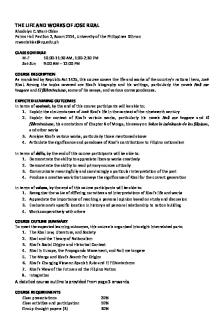
Syllabus Rizal Life and Works
- 13 Pages
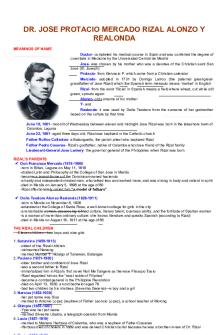
Jose Rizal Life and Works
- 35 Pages

Life and Works of Rizal
- 16 Pages
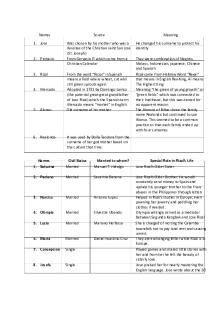
Life and works of rizal
- 3 Pages
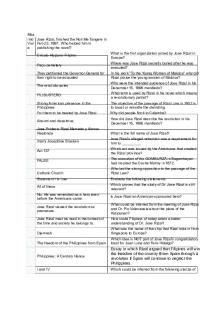
Life works of rizal
- 12 Pages

LWRN01G Life-and-Works-of-Rizal
- 156 Pages
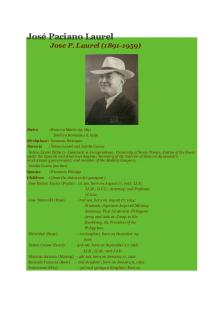
jose p laurel life works and writing
- 24 Pages
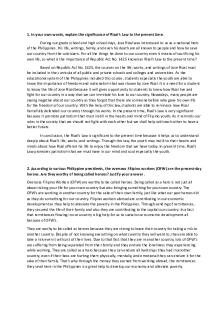
Life and works of Jose Rizal
- 2 Pages

MODULE 7 LIFE AND WORKS OF RIZAL
- 9 Pages

Module in LIFE AND Works OF Rizal
- 97 Pages

LIFE-AND- Works-OF- Rizal- Summary
- 73 Pages
Popular Institutions
- Tinajero National High School - Annex
- Politeknik Caltex Riau
- Yokohama City University
- SGT University
- University of Al-Qadisiyah
- Divine Word College of Vigan
- Techniek College Rotterdam
- Universidade de Santiago
- Universiti Teknologi MARA Cawangan Johor Kampus Pasir Gudang
- Poltekkes Kemenkes Yogyakarta
- Baguio City National High School
- Colegio san marcos
- preparatoria uno
- Centro de Bachillerato Tecnológico Industrial y de Servicios No. 107
- Dalian Maritime University
- Quang Trung Secondary School
- Colegio Tecnológico en Informática
- Corporación Regional de Educación Superior
- Grupo CEDVA
- Dar Al Uloom University
- Centro de Estudios Preuniversitarios de la Universidad Nacional de Ingeniería
- 上智大学
- Aakash International School, Nuna Majara
- San Felipe Neri Catholic School
- Kang Chiao International School - New Taipei City
- Misamis Occidental National High School
- Institución Educativa Escuela Normal Juan Ladrilleros
- Kolehiyo ng Pantukan
- Batanes State College
- Instituto Continental
- Sekolah Menengah Kejuruan Kesehatan Kaltara (Tarakan)
- Colegio de La Inmaculada Concepcion - Cebu
